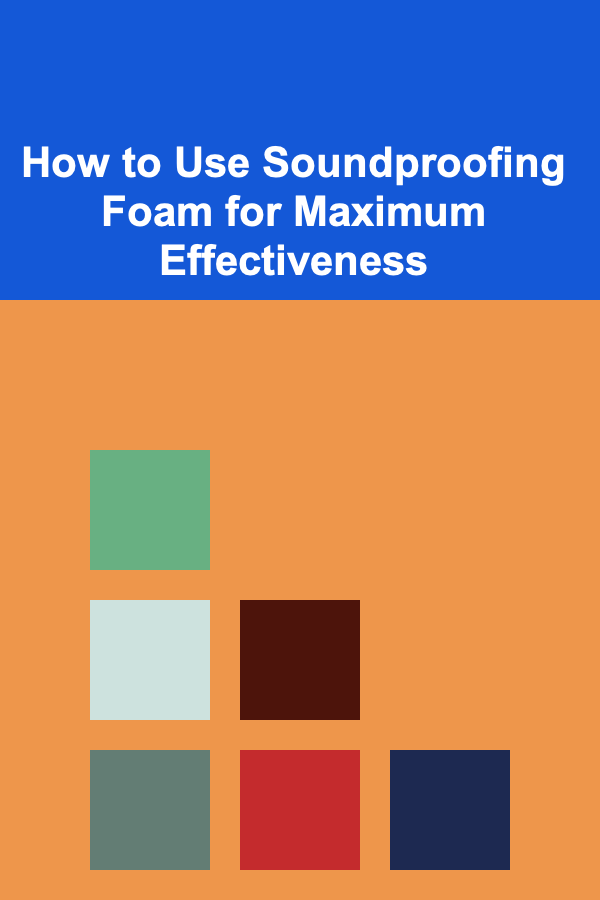
How to Use Soundproofing Foam for Maximum Effectiveness
ebook include PDF & Audio bundle (Micro Guide)
$12.99$11.99
Limited Time Offer! Order within the next:

Soundproofing foam is a popular and effective material used to reduce noise and improve the acoustics of a room. It is commonly used in recording studios, home theaters, offices, and any other environment where sound control is important. When used correctly, soundproofing foam can significantly reduce unwanted noise, enhance sound quality, and create a more comfortable, quiet environment. However, the key to maximizing its effectiveness lies in understanding how to use it properly.
In this article, we will delve deep into the world of soundproofing foam, covering its properties, different types, and how to use it most effectively for various applications. Whether you're a musician looking to optimize your studio's acoustics, or someone trying to make your home office a quieter space, this guide will walk you through everything you need to know.
What is Soundproofing Foam?
Soundproofing foam, also known as acoustic foam, is a type of open-cell foam that is designed to reduce sound reflections and absorb sound waves. Unlike traditional insulation materials that block sound from entering or leaving a room, soundproofing foam works by controlling the sound inside a room. It reduces echoes, reverberations, and unwanted noise by absorbing sound energy and preventing it from bouncing off walls, ceilings, and floors.
Soundproofing foam is typically made from materials like polyurethane, melamine, or other specialized foams. These materials have the unique ability to trap sound waves within their open-cell structure, converting sound energy into heat. This helps to improve the acoustics within a room, ensuring that sound is more controlled and clear.
Key Properties of Soundproofing Foam
- Absorption: Soundproofing foam is designed to absorb sound waves rather than reflect them. The foam's porous nature allows it to trap sound waves, reducing their intensity and preventing them from bouncing back into the room.
- Noise Reduction: Soundproofing foam can significantly reduce noise levels within a space. It can help minimize the amount of sound that escapes a room, as well as the amount of external noise that enters.
- Acoustic Improvement: In addition to reducing noise, soundproofing foam can improve the overall acoustics of a room. It helps to reduce echoes and reverberations, creating a more balanced and accurate sound environment.
- Ease of Installation: One of the most attractive features of soundproofing foam is its ease of installation. It comes in various shapes and sizes, including tiles, wedges, and pyramids, making it easy to apply to walls, ceilings, and floors.
Different Types of Soundproofing Foam
There are several types of soundproofing foam available on the market, each with unique properties suited for different purposes. Understanding these types will help you choose the right foam for your needs.
1. Acoustic Foam Panels
Acoustic foam panels are the most common type of soundproofing foam. They are typically square or rectangular tiles made of polyurethane or melamine foam. These panels are designed to absorb sound waves, reduce echoes, and improve sound clarity within a room. Acoustic foam panels come in various thicknesses and densities, with thicker panels generally providing better sound absorption.
These panels are ideal for home studios, offices, or living rooms where sound quality is important. They are often used on walls and ceilings to treat the acoustic properties of a room. Acoustic foam panels are available in different styles, including flat panels, wedges, and pyramids, allowing you to customize the appearance and functionality of your space.
2. Bass Traps
Bass traps are a specialized form of soundproofing foam designed to absorb low-frequency sound waves (bass). These are typically placed in the corners of a room, where low-frequency sound tends to build up. Bass traps are larger and thicker than regular acoustic foam panels, and their shape is usually triangular or cylindrical to fit in the corners.
Bass traps are particularly useful for reducing the booming or muddiness that often occurs in a room due to low-frequency sound reflections. They help to balance out the overall sound, especially in home theaters or recording studios where bass frequencies are prevalent.
3. Acoustic Foam Wedges
Acoustic foam wedges are a variation of the standard acoustic foam panel. They are characterized by their wedge-like shape, which creates a larger surface area for sound waves to interact with. The wedge shape is highly effective in diffusing sound waves and reducing reflections in a room.
Wedge-shaped foam is ideal for treating both high and mid-range frequencies. It works well for rooms where precise sound control is needed, such as professional studios, podcasting setups, or home theaters.
4. Pyramid Foam Tiles
Pyramid foam tiles are another common type of acoustic foam. As the name suggests, these tiles have a pyramid-like structure, which helps to scatter sound waves in different directions. Pyramid foam is highly effective at reducing echoes and improving the clarity of sound.
Pyramid foam tiles are often used in environments where you need to balance sound quality and noise reduction. They are popular in home theaters, rehearsal rooms, and broadcast studios.
5. Soundproofing Foam Panels with Reflective Coating
Some soundproofing foam panels are coated with a reflective material, such as a thin layer of aluminum. These panels not only absorb sound but also reflect it in specific directions. They are commonly used in situations where sound needs to be directed or diffused rather than absorbed entirely.
This type of foam is useful in spaces where you want to enhance the acoustics in a specific area of the room while still controlling sound reflections.
How Soundproofing Foam Works
Soundproofing foam works through the principles of sound absorption and diffusion. The open-cell structure of the foam allows sound waves to enter and get trapped within the cells. As sound waves travel through the foam, they lose energy, which results in a reduction in sound intensity. The foam absorbs the sound energy and converts it into heat, which prevents it from reflecting back into the room.
The effectiveness of soundproofing foam depends on several factors, including the thickness, density, and placement of the foam. Thicker foam panels tend to absorb more sound, particularly low-frequency sounds, while denser foam provides better overall noise reduction. Proper placement of the foam is also essential for maximizing its performance.
1. Absorption of Sound Waves
The main way soundproofing foam works is by absorbing sound waves. When sound waves hit a foam surface, the foam's porous structure traps the sound and slows it down. This absorption reduces the overall energy of the sound waves, which results in less sound reflection and reverberation.
2. Diffusion of Sound Waves
Soundproofing foam can also diffuse sound waves, especially when it has a unique shape such as wedges or pyramids. Diffusion occurs when the foam scatters sound waves in multiple directions, preventing them from bouncing back into the room. This helps to reduce the buildup of sound reflections and ensures a more balanced sound environment.
3. Blocking Low-Frequency Sound
While soundproofing foam is primarily designed to treat mid- and high-frequency sound waves, some foam types, such as bass traps, are specifically designed to target low-frequency sounds. These foam types are denser and thicker to capture the longer sound waves produced by bass frequencies.
Best Practices for Using Soundproofing Foam
To achieve maximum effectiveness with soundproofing foam, it is essential to follow some best practices for installation, placement, and maintenance. Properly applying foam can significantly improve the acoustics of a room, while incorrect placement or poor-quality foam may not yield the desired results.
1. Identify the Source of Noise
Before installing soundproofing foam, it is important to identify the source of the noise you're trying to mitigate. Is the noise coming from outside the room (e.g., traffic or neighbors)? Or is it internal noise, such as sound bouncing off walls and ceilings? Understanding the source of the noise will help you decide where to place the foam for maximum impact.
2. Cover Reflective Surfaces
The most common areas where sound reflections occur are the walls, ceiling, and floor. These surfaces are typically made of hard materials like drywall, concrete, or wood, which reflect sound waves. To reduce these reflections, you should apply soundproofing foam to these surfaces.
- Walls: Place acoustic foam panels on the walls to absorb sound and prevent it from reflecting. Focus on placing foam in areas where sound tends to bounce, such as the first reflection points between speakers and the listener.
- Ceiling: If you're working in a space with high ceilings, installing foam on the ceiling can help to reduce sound reverberation. Ceiling-mounted foam is especially beneficial in rooms with a lot of hard surfaces that reflect sound.
- Floor: While foam is typically used on vertical surfaces, placing acoustic foam on the floor can help reduce impact noise and improve overall acoustics. This is particularly useful in home theaters or studios.
3. Use Bass Traps in the Corners
Bass traps are crucial for controlling low-frequency sound. These should be placed in the corners of the room, where bass frequencies tend to accumulate. Bass traps can help to smooth out the bass response, making the sound in the room more balanced and clear.
4. Consider Foam Thickness and Density
For the best results, consider the thickness and density of the foam you're using. Thicker foam panels provide better absorption, especially for low-frequency sounds. However, they may also take up more space and reduce the overall room volume. If you have limited space, thinner foam may still provide effective noise control.
5. Cover the Entire Room
For optimal soundproofing, it is important to cover as much of the room as possible with foam. Focus on the areas where sound reflections are most likely, such as the walls and ceiling. If you're treating a room for recording, also consider covering any reflective surfaces such as windows, doors, or mirrors.
6. Keep the Foam Clean
Soundproofing foam can accumulate dust and dirt over time, which can reduce its effectiveness. Regularly cleaning the foam will help to maintain its performance. Use a vacuum cleaner with a soft brush attachment to gently clean the foam, or use a damp cloth to wipe down the surface.
Conclusion
Soundproofing foam is an effective and affordable solution for improving the acoustics of a room and reducing noise. By understanding how it works, selecting the right type of foam for your needs, and following best practices for installation, you can create an ideal sound environment in any space. Whether you're working in a recording studio, home theater, or simply trying to reduce noise in a home office, soundproofing foam can provide the control and clarity you need for the best auditory experience.
With proper planning and the right materials, soundproofing foam can dramatically improve both the sound quality and the quietness of any room, making it an essential tool for anyone looking to optimize their acoustic environment.

Becoming a Successful Financial Analyst: Essential Skills for Forecasting and Reporting
Read More
How To Become a Virtual Assistant: A Comprehensive Guide
Read More
How to Deep Clean Your Kitchen Like a Professional
Read More
How to Keep Your Pet's Ears Clean and Free of Infection
Read More
How to Set Up Motion-Sensor Lighting Around Your Home
Read More
How to Use Clear Labels for All Containers
Read MoreOther Products

Becoming a Successful Financial Analyst: Essential Skills for Forecasting and Reporting
Read More
How To Become a Virtual Assistant: A Comprehensive Guide
Read More
How to Deep Clean Your Kitchen Like a Professional
Read More
How to Keep Your Pet's Ears Clean and Free of Infection
Read More
How to Set Up Motion-Sensor Lighting Around Your Home
Read More